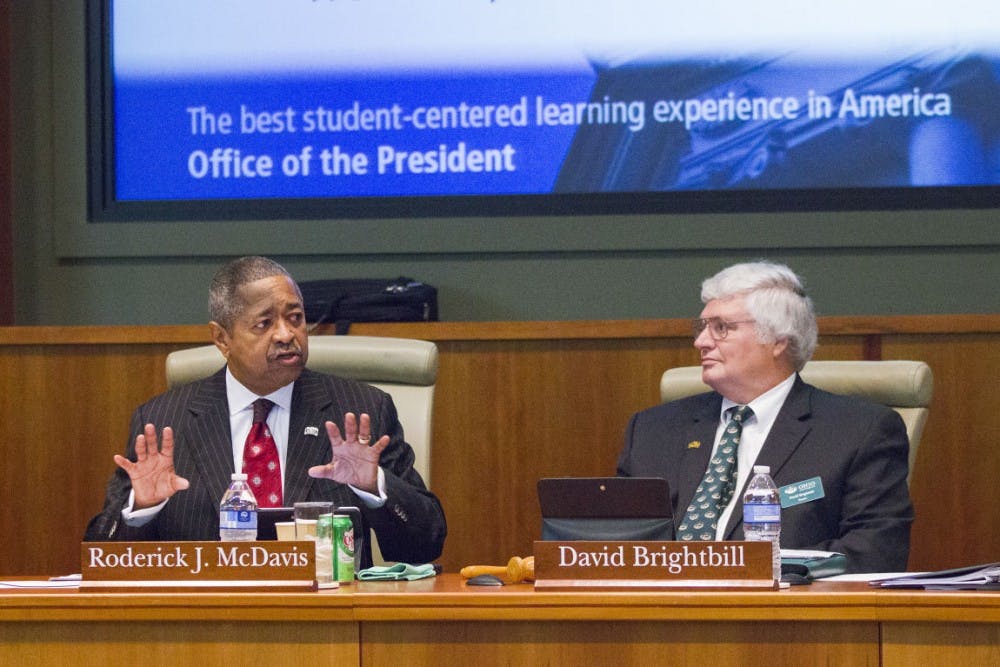Correction appended.
Ohio University students could see updates to buildings such as Clippinger Hall and Alden Library in the university's multi-year plan for construction and renovation projects.
Officials presented updates to the Capital Improvement Plan, which details upcoming university projects and outlines how officials expect to pay for them, during the Board of Trustees meetings Thursday.
Some of the main goals for the 2017-22 plan include Housing and Residence Life projects, regional campus renovations, Ohio Information Technology updates and deferred maintenance.
The six-year total cost for the plan is expected to be about $796 million with $333 million of that in deferred maintenance, according to the board’s agenda. Deferred maintenance refers to any projects the university has postponed to save money or reduce costs.
About $291 million will come from the university's internal bank and about $148 million will come from the university's century bond, a debt strategy that allows the university to reduce the cost of deferred maintenance. Other sources of funding include state appropriations, gifts, grants and reserves.
About $226 million of the total is expected to go to Housing and Residence Life projects, which includes current renovations to Jefferson Hall and future upgrades to residence halls. Jefferson Hall's market will be renovated to include a deli, café and tea room, and the residence hall will be updated with improved dorm rooms and a new elevator.
“Building on the Ohio culture of interdisciplinary collaboration, this (plan) integrates the complex planning efforts and input of faculty, staff, students and alumni from all disciplines and functions across the university,” Deborah Shaffer, vice president for Finance and Administration, said.
The Capital Planning Team, made up of officials from University Planning, Facilities, Finance and the Provost’s office, will work on the project until March. Then, the Capital Funding and Priorities Committee will make final adjustments before giving officials the go-ahead to present the plan for approval at the Board of Trustees' June meeting.
“Guided by the university’s strategic and master planning efforts, we are presenting an integrated capital improvement plan that balances programmatic and deferred maintenance priorities and supports growth, while respecting and considering our institutions financial capacity and affordability,” Shaffer said.
Shawna Bolin, director of University Planning and Space Management, said the plan presents ideas on how to create more usable space for the university.
Some of the university’s projects that fall under the Capital Improvement Plan include renovations to Alden Library and Clippinger Hall.
Bolin said the Russ College of Engineering and Technology has “insufficient research space” and they’re working to expand to the West Union Street Office Center to allow all of the department's research to take place in the same building.
University officials are also working to add more “24/7 space” in the library, she said. In some of its renovations this past summer, the library was updated to include a new gender-neutral bathroom and a new roof.
Bolin added that the university is playing “catch-up” when it comes to renovations, but they hope to soon be playing “keep-up” instead.
Trustee Dave Scholl said it was important to take into account the expectations of professors and students using the facilities. He said officials need to make sure faculty and students benefit from new facilities, so the university's money is being used wisely.
Some of the other problems the university is addressing in the plan are the buildings that are located in the floodplain, such as Clippinger, and updates to building infrastructures. Low-lying buildings on campus could face flooding from the Hocking River when there are high water levels.
Shaffer called the project a “Herculean effort” and said the group of people who helped with the project have put in a lot of work.
The group expects to update the plans next year to cover the fiscal years 2019 through 2024.
Correction: A previous version of this article incorrectly identified the location of the Russ College of Engineering and Technology’s expansion. The college expects to develop and move to the West Union Street Office Center. The article has been updated to show the most accurate information.






